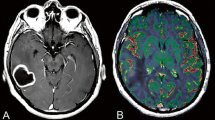Abstract
The morpho-functional reorganization of regional vascular arteries is greatly altered after the induction of arterial hypertension (AH) in experimental rats. These changes can be examined using magnetic resonance imaging methods. In our experiment, induced AH caused arteriostenosis of cerebral arteries in two strains of rats—Wistar and OXYS (p < 0.05). In addition, we studied the changes in renal arteries in the same experiment. Compensatory vasodilatation was found in the extrarenal part of arteries. Arteriostenosis was detected in the intrarenal part of arteries, which was due to cytotoxic hypostasis of renal parenchyma. We proposed a cerebral vascular index and applied this index for precise analysis of changes in the studied arteries. This index is calculated as the ratio of the diameter of cerebral arteries to the diameter of renal arteries. The degree of differences in vasoconstriction between cerebral and renal arteries was established. Our results showed a moderate degree of differences in the vasoconstriction of cerebral arteries. In addition, the degree of differences in the vasoconstriction of intrarenal arteries revealed deeper vasoconstriction. These distinctions are 28.1% (p < 0.05) and 60.9% (p < 0.05) for Wistar and OXYS rats, respectively. Arterial morphometry revealed reduced sizes of all OXYS rat arteries compared with those of Wistar rat arteries. These pathological changes were associated with excessive stiffness (rigidity) of vascular walls due to accelerated aging. The accelerated aging of OXYS rat arteries led to a decrease in their vasodilatation potential and a decrease in the blood supply of cerebral and renal arteries. Comparative morphometry of the status of all arteries in both groups after AH revealed multiple specific changes in the remodeled arteries.


Similar content being viewed by others
References
D. Ettehad, C. Emdin, A. Kiran, Lancet 5(387), 957–967 (2016)
F. Viazzi, B. Bonino, R. Pontremoli, M. Muiesan, M. Salvetti, G. Schillaci, G. Pucci, A. Signori, J. Hypertens. 9(34), 1689–1697 (2016)
Y. Vasyuk, S. Ivanova, E. Schkol’nik, Y. Kotovskaya, V. Milyagin, V. Oleynikov, Y. Orlova, A. Sumin, A. Baranov, S. Boytsov, A. Galyavitch, Z. Kabalava, Cardiovasc. Therapy Prevent. 15(2), 4–19 (2016)
Zh Kabalava, Yu. Kotovskaya, A. Bogomaz, Ration. Pharmacotherap. Cardiol. 12(3), 317–324 (2016)
E. Gogin, Terapeut. Arch. 4, 5–14 (2011)
V. Moiseev, N. Mukhin, Zh Kabalava, S. Villevalde, M. Ehpremovtseva, L. Kozlovskaya, Yu. Kotovskaya, V. Fomin, S. Shalnova, F. Ageev, Cardiovasc. Therapy Prevent. 7(6), 1–20 (2008)
Y. Motin, A. Zsarikov, V. Bryuhanov, Morphology 5(1), C.33–C.37 (2011)
I. Agafonova, V. Kotelnikov, N. Kolosova, V. Stonik, Appl. Magn. Reson. 42(4), 487–497 (2010)
N. Kolosova, N. Stefanova, S. Sergeeva, in Handbook of Cognitive Aging: Causes, Processes and Effects, ed. by Q. Gariépy, R. Ménard (Nova Science Publishers, Hauppage, N.Y. USA, 2009), pp. 47–82
N. Kolosova, T. Scheglova, T. Amstislavskaya, I. Loskutova, Bull. Exp. Biol. Med. 135(6), 593–596 (2003)
T. Novgorodceva, M. Antonyuk, V. Kotelnikov, I. Agafonova. Patent of Russian Federation, No 2327228 June, 20, (2008)
I. Agafonova, V. Kotelnikov, N. Kolosova, V. Stonik, Appl. Magn. Reson. 4(42), 487–489 (2012)
I. Agafonova, N. Kolosova, V. Rasskazov, Pac. Med. J. 1, 104–107 (2012)
B. Geltser, V. Kotelnikov, I. Agafonova, P. Luk’yanov, M. Antonyuk, T. Novgorodtseva, Bull. Exp. Biol. Med. 144(1), 33–35 (2007)
I. Agafonova, V. Kotelnikov, U. Eichoff, Appl. Magn. Reson. 45(5), 527–536 (2014)
J. Booth, P. Muntner, M. Abdalla, K. Diaz, J. Schwartz, D. Shimbo, A. Viera, K. Reynolds, J. Hypertens. 2(34), 235–243 (2016)
R. Oganov, O. Drapkina, Cardiovasc. Therapy Prevent. 15(4), 4–9 (2016)
Acknowledgements
The study was carried out on the equipment of the Collective Usage Center PIBOC FEBRAS, “Far East center of noninvasive radio-frequency diagnostics of biological objects” (FECNRFD). The research is partially supported by a grant from the Russian Scientific Fund (project No. 14-25-00037) and FEBRAS Grant No 15-I-5-006.
Author information
Authors and Affiliations
Corresponding author
Rights and permissions
About this article
Cite this article
Agafonova, I.G., Kotelnikov, V.N., Geltcer, B.I. et al. The Morpho-Functional Characteristics of Cerebral and Renal Arteries After Induced Arterial Hypertension in Rats Using Magnetic Resonance Imaging. Appl Magn Reson 48, 911–919 (2017). https://doi.org/10.1007/s00723-017-0914-9
Received:
Revised:
Published:
Issue Date:
DOI: https://doi.org/10.1007/s00723-017-0914-9



